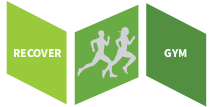The shoulder joint is the most movable joint in our body. It can pretty much move in any direction, It’s capable of that because our shoulder joint is formed by the union of the humerus, the scapula (or shoulder blade), and the clavicle (or collarbone)
Actually it’s only one tiny ligament stabilizing the shoulder directly, the rest of the ligaments in the shoulder are indirect ligaments, which do not pass over the shoulder joint. There are more than 20 muscles which have to move and stabilize the shoulder actively, which is very important, exactly because of the lack of passive stability.
Frequently people who suffer from shoulder pain are told by doctors or therapeutics that they should rest their shoulders. But nothing could be more wrong. If you don’t use and activate your shoulder muscles, they will weaken and shrink in (atrofi) and you end up being worse off.

Find your injury in the list below:
Ligament injury in the shoulder (Glenohumeral distortion)
Dislocated shoulder (Luxation)
- Clear shoulder deformity where the shoulder is no longer round.
- Extreme pain especially when trying to move.
- Muscle spasms.
- No movement, the arm hangs limply down the side.
Pinched nerve (Neuritis)
Shoulder instability (Glenohumeral instability)
- Uncomfortable clicking or clonking from the shoulder at certain movements.
- Possible dead arms sensation.
- Weakness
- Diffuse aches in the shoulder region.
- Pain at the back of the joint and in the posterior stabilizing muscles.
- Possible sensation of loosening in the shoulder.
- Anterior dislocation.
Frozen shoulder (Adhesive captulitis)
- Initially pain is subtle and may disappear when the patient starts moving.
- Later more intensive pain.
- Disturbed night sleep due to intense nightly pain located deep in the shoulder.
- Radiating pain in the arm.
- Muscular locking of the entire shoulder complex.
- Reduced mobility. First outward rotation ⇒ exit ⇒ forwarding.
- RC atrophy. (diminished stability muscles in the shoulder).
- The pain disappears to some degree when the arm is kept still in inwards rotation alongside the body.
Bursitis in the shoulder
- Gradual pain at the shoulder joint.
- Pain in front of and above the shoulder joint.
- Pain in motion; even symptoms like rotator-cuff inflammation.
- Reduced mobility.
- Soreness over the shoulder joint.
Impingement syndrom
- Pain in the shoulder.
- The pain may get worse at night.
- Pain during outward and upward movement of the arm (painful arch).
- Pain during forward movement of the shoulder with the palm downward.
- Pain is provoked by horizontal movement of the arm across the body.
- Possible pain on the back of the arm (hand in the back pocket).
- Local point of pain on the shoulder.
- Pain on the front of the shoulder and arm.
- Possible “stiff” or frozen shoulder.
- Possible crepitation (sore feeling).
- Evt. smerte over 90º fremadføring og udadføring.
- Possible spasms between the shoulder blades (rhomboid muscles and upper / lower trapezius).
External impingement of the shoulder
Upper cross syndrome
- Bursae problems in the shoulder.
- Neck pain.
- Headache.
- Radiating symptoms in the arms etc.
- Impingement syndrome in the shoulder.
Rotator cuff tendinitis
- Proportionally increasing symptoms.
- Pain and soreness in the shoulder joint.
- Decreased mobility due to pain (outer and forward movement and rotation of arm).
- Often soreness in the shoulder / Neck region.
- Often rotator-cuff weakness (especially m. supraspinatus).
- Soreness during muscular activity.
- Movement pattern can exhibit a lifting of the shoulder when attempting to lift the arm (showing a change in the upper and shoulder blade rhythm – often visible when the problem is exacerbated.)
Prolapsed disc in the neck
- Local pain at the site of the prolapse and possible radiating pain into one leg exacerbated by exertion.
- Prickling sensations the area of nerve intervention (dermatome).
- Svaghed i armen.
- Reflexes may be altered.
- Functional failure due to direct pressure on the nerves.
Thoracic Outlet Syndrome / TOS (chest/neck nerve impingement)
- Pain in shoulder and neck.
- Pain in arm.
- Pain in hand.
- Sleeping, pricking and stabbing sensations into the hand.
- Skin color change in hand and arm.
- Cold hand.
- Weak pulse in arm and hand.
- Weak gripping strength in hand.
- A pounding sensation at the collar bone.
- In the worst case a blood clot under the collar bone.
Repetitive strain injury (RSI) / Myositis
- Sore neck, shoulders, arms and wrists.
- Træthed i nakke, skuldre og arm.
- Pain in the neck, shoulders, arm, elbow, wrist and headache.
- Increased pain at continued use.
- Relief with rest.
Winged scapula (Scapula alata)
- Pain in the shoulder as in impingement syndrome.
- Reduced function of the shoulder blade.
- Curved posture of the upper back.
- Resulting injuries of the shoulder, neck and arm.

Social Medier